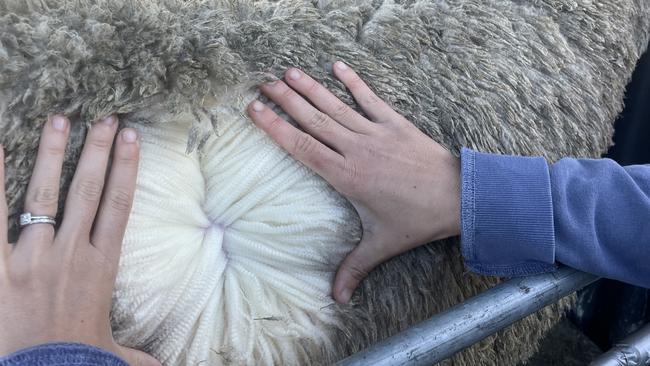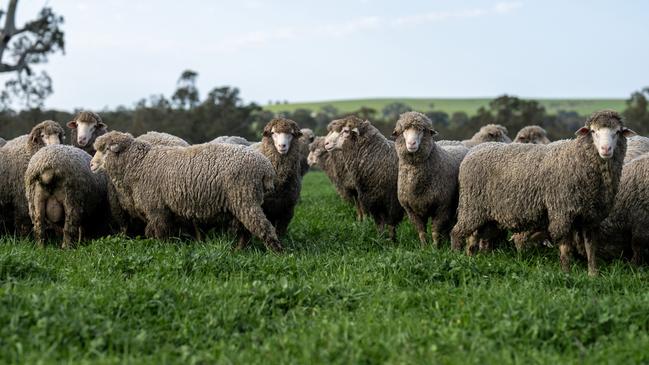Knockout punch for Merinos in national prime lamb competition - how one breeder scored the best
Merinos could rival crossbred lambs for quality and returns if the results from one breeder can be repeated. See how their Merino breeding strategy took on the prime lamb industry and won.

Quality is the aim and measurement is the means for one Western District Merino enterprise which is unashamedly different to most operations.
And it’s measurements that have allowed Mooralla Merinos to develop a stud and commercial flock where the wool and meat quality gain the highest accolades.
The Luhrs family run a grazing operation 30 minutes north of Hamilton, with Ricky, his wife Marni, and their children, alongside his father Russell, all focused on profitable commercial stock.
With an overarching philosophy of wool, meat and welfare, the team has used Australian Sheep Breeding Values and infusion of specific genetics to achieve their goals.
“We want to produce a highly fertile Merino that is productive and efficient in an intensive grazing system maintaining good feet and wool quality in high rainfall,” Ricky said.
“All of the traits we focus on have equal priority for us, we are particularly excited about the welfare traits and the opportunities to continue to develop the modern Merino.”
A close working relationship with Andrew and Mandi Bouffler from Trigger Vale at Lockhart, NSW, has seen their stud flock develop its meat credentials, with multiple meat science trials joint with Meat and Livestock Australia at major abattoirs like JBS Bordertown, South Australia, and Fletchers at Dubbo, NSW.
This has coincided with a planned micron rise from 17 microns to 19 microns to help achieve these goals for meat and wool.
BRED FOR SUCCESS
Twelve years of careful selection of genetics has, Ricky said, allowed them to breed a modern Merino with the ability to not only produce quality wool but carcasses that compete with the best terminal-sired lambs.
And that breeding strategy is starting to pay off, not the least of which was at the recent Lambex feedlot carcass competition, where a draft of commercial Mooralla Merinos took top honours.

It reinforced to Ricky and his team that Merino progeny, if carefully selected, could supply the prime lamb industry and achieve premiums.
Mooralla is a family-run operation with 4500 commercial breeding ewes and 500 stud ewes, which are joined to supply rams for their own operation as well as external sales.
When it became clear that maximising returns from Merinos needed contributions from both wool and meat, the Luhrs started infusing genetics with high ASBV figures for post weaning weight, eye muscle area and fat.
“You are looking for growth and weight, but you also need that fat and muscle with balanced fleece component in Merinos,” Ricky said.
“We want sheep that are able to do well even in the tough times.”
Alongside the preferred breeding numbers had to be a suitable phenotype – there had to be a muscle presence on rams and shape.
“If you want to be rewarded for breeding crossbred-type lambs and paid the same price, you have to produce Merino lambs that have crossbred-type carcasses,” he said.
“I’d say that there is only a low percentage of Merinos in Australia that have that, maybe 5-10 per cent.
“But it is where we want – and need – to be as Merino breeders.”
COMMERCIAL GAIN
The commercial operation at Mooralla is where the genetic decisions made at a stud level are playing out.
About 3000 of the 4500 Merino ewes are joined to their own Merino genetics, while another 1500 ewes are joined to Poll Dorsets.

They join 1500 ewes to a terminal to help the commercial flock to continue to improve – by allocating the classed out ewes to a terminal, the less desirable genetics are not carried on.
The Poll Dorset-sired lambs are turned off at between six and nine months, depending on the season, while the Merino lambs are closer to seven to 10 months.
All are sold above 22kg carcass weight, and preferably at an average of 25kg carcass weight and heavier, direct to abattoirs.
This year, all of the sheep have been fed in containment pens, due to the tough conditions through autumn and winter.
There’s been nowhere near the regular falls that usually make up the annual 550mm rainfall.
The containment pens were established in 2003-04 to give breathing space for pastures and to always be able to maintain adequate ground cover and protect soils and environment.
There is enough space in the pens to hold all breeding ewes and weaners, and while it can be labour intense, the Luhrs never hesitate to do it.
“We have light soils and even with an average stocking rate, we can get below ideal levels of ground cover in late summer and autumn, even in a good year,” he said.
“We have these pens so we can ease the pressure on our country, maintain ground cover and when there is a rain, allow country and pastures to get away before lambing.”
This year was one where the containment areas came into their own.
Sheep were fed a ration of home grown silage and grain they bought in, and were only let out of the pens when they were lambing down in June and July. Ewes were fed to keep them in condition score 2.8-3.1 depending on pregnancy status (single or twin) to ensure lambing did not cause losses.
At the same time, overall numbers were lightened including a line of Merino ewe lambs, which had been ear marked for keeping, were instead put into feeding pens to be finished to sell to processors.
While Ricky said that was not the original plan – they were to be joined and lambed down – it showed the flexibility and importance of maximising the dual income streams from Merinos.
“Those ewe lambs went into the feedlot, gained 240 grams a day, and were sold in June-July and averaged $208,” he said.
“Add to that their wool value of $35 at February shearing and it shows what can be done, even in a tough season.”

NATIONAL ACCLAIM
The Mooralla focus on meat was also on show at Lambex, where their sheep won the AMPC Feedlot Carcass Competition and were named Australia’s top performing lamb producer.
The winning lambs were not from their top lines because they were too heavy to be eligible, and instead from their third draft of lambs which were light enough to meet the entry weight requirements of 32-38kg delivered to Thormby feedlot in the first week of December last year.
Carcass points were awarded for hitting the ideal grid, lean meat yield percentage, fat score and MSA index alongside hot standard carcass weights.
Other points were allocated for feedlot performance and fleece value.
While Mooralla did not win any of these categories outright, they did well enough in each to make their overall performance the best of any entries of any breed.
And that’s the point – Mooralla wants its own flock and any clients – to make profit from more than just one income stream.
Ricky concedes that wool has increased in strength as planned as a result of the push for carcass quality – the flock is now two microns broader than it was about a decade ago, moving from 17 micron to 19 micron.
The sheep still grow the same amount of wool, with adults cutting about 5.2kg to 5.3kg over 12 months when shorn every eight months, or three times every two years.
At that shearing interval, wool length still reaches 90mm with eight or nine months growth.
For the past six years, wool has been contracted to ZQ in New Zealand, to produce its Icebreaker range of clothing.
Whether it is meat or wool, Ricky said his goal was to be known for quality, and profitability should follow as a result.
“We want to be rewarded for producing a quality product,” he said.
“For wool, of course, Merinos are well known for this but they aren’t recognised for it in meat, and to be honest, there are Merinos where meat yield and quality would be an issue.
“But if you are prepared to focus on meat quality, as we have, then it shouldn’t be a detriment that it comes from Merinos if we can match the quality with the crossbreds and that’s what we are doing.”


